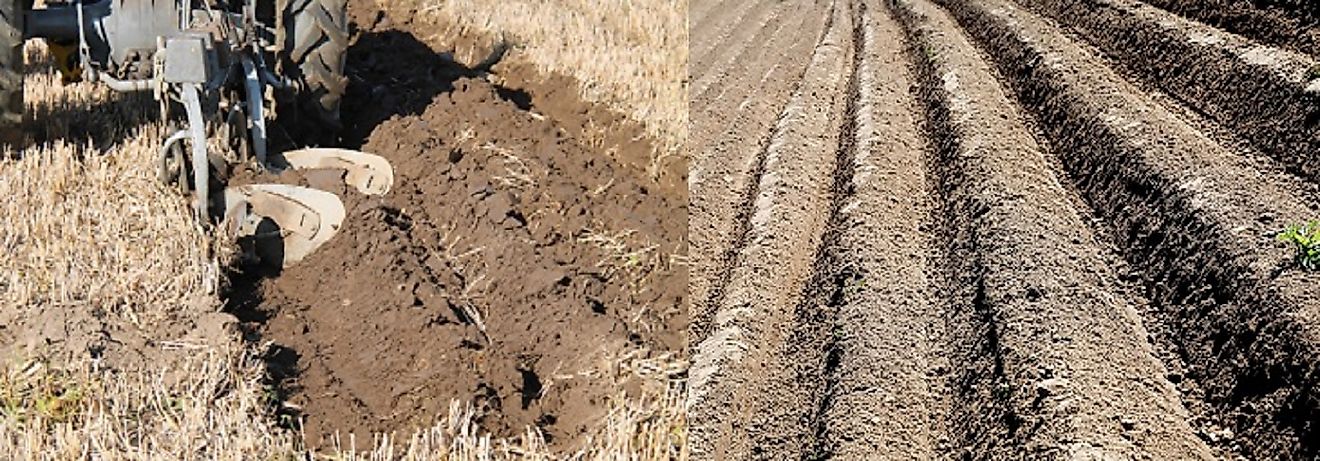What Is A "Furrow" (in Agriculture)?

Description
In agriculture, a furrow is a trench or groove made on the soil surface by a hoe, a beast of burden-pulled plow, or a tractor, wherein seeds are sown and fertilizer is placed before its furrow is closed up. Sowing on a furrow also manages non-wetting sandy or waxy soils by allowing seeds to be placed deeper into the soil in lower topsoil or shallow subsoil layers, which is often more wet, according to the Grains Research and Development Corporation, Australia. Where the top fertile layer of top soil has been eroded or blown away by the wind, furrows slow water runoff and improve permeability, so that plants native to that ecosystem can regenerate, according to the Australia Department of Environment.
Agronomic Application of Furrows
When side dressing crops, a process where fertilizer is applied immediately next to crops, a furrow is dug where fertilizer is applied, and then buried. A furrow may also be dug to move water in irrigation systems. Furrow irrigation is suited for large- and small-scale farmers alike, though there is much labor when there is little investment for the use of mechanized means of creating such systems. This approach can also be used on different soils and slopes, according to a Helvetas Report, making it one of the most widely used surface irrigation technologies in the world. Furrow irrigation also allows greater flexibility in crop rotations, more efficient water management, and improved soil structure, according to a New South Wales (NSW) Agriculture Department report.
Crops Best Suited to Furrows
Furrow irrigation is also ideal for crops prone to damage when water covers their stems or crowns, such as tomatoes, root vegetables, potatoes, and beans. It’s also utilized when growing fruit tree and vine crops like grapes or citrus. For such, a furrow is dug alongside the trees or vines in early planting stages to hold and improve water spread. Other crops suited for furrow irrigation are maize (corn), oilseeds such as sunflower, sugarcane, rice, wheat, and soybeans. Crops grown through furrow irrigation are more tolerant to excessive watering than those irrigated on flat land due to improved re-aeration of the soil after the furrow is drained. However, watering duration needs to be 12 hours or less for most crops, as water-logging also occurs even on sloped land. Long duration watering also lowers yields for legumes like beans significantly, and may worsen soil erosion, according to the NSW Agriculture Department.
Furrow Gradient in Land Surface
A furrow also drains surface water in soils that have an impermeable top layer of soil caused by over-tiling practice and/or excess rains. Uniformly flat or gently sloped lands are the most suited for furrow irrigation, as in these drainage effectively occurs after excess irrigation or rainfall and thereby prevents excess soil erosion. There are, however, certain seeds that are susceptible to damage when sowed with fertilizer on a furrow. According to Nutrient Stewardship, oilseeds like soybeans are damaged by in-furrow fertilization, unlike maize seeds, which have higher nitrogen requirements and tolerance against burning from fertilizer application.
Tilling Former Crops Back Under
According to the University of Nebraska, when planting wheat during the winter furrows provide a rough soil surface which helps stop wind erosion. Wheat drilled in furrows is also protected against winterkill. Also, using hoes means the wheat seed is planted in mulched soils that are a byproduct of stubble from the mulching of the remnants from formerly harvested crops' residues, and as such makes for more effective tillage practices. This preserves the maximum amount of crop residue, and anchors plants well enough in the soil to prevent wind soil erosion. In addition to hoes, furrow drills with large discs can also be used to plant in mulched soils.
Practical Application of Tilling Residue Into Furrows
To reiterate, planting in furrows with hoe openers permits growers to plant in mulched soils that result from the aforementioned stubble-mulching tillage practices. This planting technique preserves the maximum amount of surface residue, and anchors plants securely for maximal wind erosion control. Furrow drills with large discs may also be satisfactorily used to plant in mulched soils.











